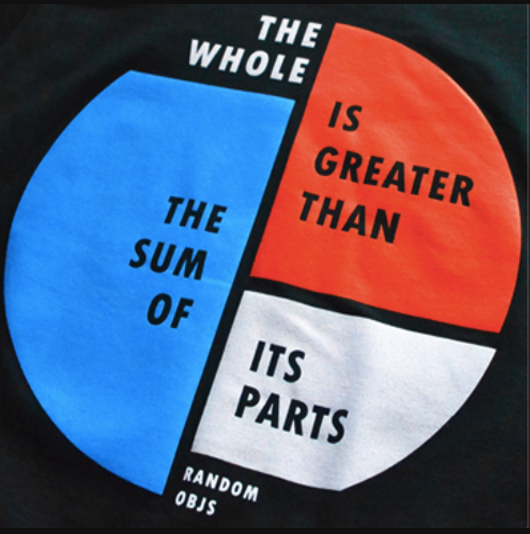Our team includes physicists and mathematicians so it’s second nature for us to work on equations. But our focus is management. That’s why we had to work in the field with companies over many years to develop a solution that was both scientifically solid and highly practical.
In every sector, most companies are designed to operate with a mechanistic and linear approach that is no longer sufficient in our times of complexity. Traditional organigrams and vertical, siloed functions create artificial barriers to the speed of flow that is now crucial for success. These barriers disempower people and create unnecessary friction and frustration.
The good news is that with the appropriate knowledge, method and tools, companies can deliver superior Quality, create more involvement for people and accelerate cash flow.
Systems science and network theory are updating how we understand reality. We realized that they could also provide the way ahead for companies to compete. A systemic understanding of reality enables leadership to connect dots they would not otherwise see and to strategize, plan and execute at a whole new level. When companies understand their organization as a system, they can find their unique leverage point to propel their performance and achieve significant and sustainable growth. This insight enables them to develop a systemic offer for the market that competitors cannot imitate while improving performance company-wide to deliver their offer reliably.
We cracked the sustainable growth equation by developing a step-by-step approach that we transfer to transformational decision makers with the authority and responsibility to make meaningful change. We call it the Decalogue.

The Decalogue
Realizing the interconnected nature of challenges your customers are facing and developing systemic solutions for them is a game changer. When you back this up with a systemic approach to designing how you operate and deliver your products and services, it takes you to a whole new level of sustainable growth. This is what our Decalogue method is for.
The Decalogue method equips companies with the knowledge they need to shift to a systemic approach in the way they operate their organization. It is a shift in perception and behaviour based on systems science and that focuses on interconnections and interactions.
Systems science emerged mid twentieth century. Understanding a company as a whole system, a network of interdependent components that work together to achieve a common goal, is not new. It dates back to the work of Dr. W. Edwards Deming in the 1950s. When they paid great attention to Deming’s lessons, the Japanese rose from catastrophe to become an economic powerhouse.
But just being aware that a company is a system is not enough. You need a method (and tools) to harness the advantages of thinking and operating systemically. The Decalogue enables companies to grow while enhancing the performance and control over operations (marketing, sales, R&D, manufacturing, project management, finance, etc.) through a method that combines three fundamental aspects:
-
How to manage variation in processes and interactions
-
How to synchronize processes and projects through a strategically chosen leverage point (constraint)
-
How to organize your resources in a way that capitalizes on this knowledge (Network of Projects)

Breakthrough solutions
The Decalogue method is a new kind of science for organizations. It enables companies to continuously find breakthrough solutions that make good sense and add high value. These breakthrough solutions are inherently systemic and take into account all stakeholders. They are driven and sustained by a different approach to management and a way of organizing resources that we call “Network of Projects”. This removes silos and artificial barriers, leading to increased Quality, Involvement and Flow.
You can find out more about the Decalogue here.

The catch…
The ride is free but the door ain’t open, to paraphrase Bruce. How can you open that door?
The price that you pay to open the door is learning.
Knowledge is orderly, cumulative and often rational. But challenging what we think we know so we can acquire new knowledge can be emotionally and cognitively challenging. The journey we need to embark on is learning how to transform fragmented, siloed and separately managed activities into a cohesive and coherent network of conversations focused on the goal.
Even when we know what to do, why do we get stuck?
Without cognition, there can be no life. Cognition, in individuals and organizations, refers to all the processes involved in gaining knowledge and comprehension. Over the years, we have witnessed how every organization has its own “cognitive constraint”; these are mental models (assumptions) that prevent the company from moving forward. The Decalogue provides the elements of knowledge and method to overcome this by identifying and invalidating self-limiting assumptions. It transfers to companies the thought process to create a well-defined path to transition from the present to a more desirable future. This path increases leadership confidence by being carefully monitorable.
As Dr. Deming used to say, learning is not compulsory, but neither is survival. Human life is a continuous process of cognition. No positive change is possible without some preliminary learning.
It had to be us to crack the sustainable growth equation because…
Our team has been together for a very long time, and our competencies span from theoretical physics to contemporary literature. We have produced our results by leveraging our talents as physicists, mathematicians, computer scientists and writers, and our human-centered approach permeates everything we do. Our love for science enabled us to combine the work of W. Edwards Deming and the Theory of Constraints into a cohesive whole. Our strong European roots connect us with centuries of reasoning and art while our new found land, Canada, provides wide open spaces for innovative thinking and action.







